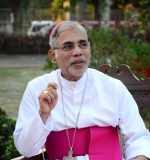Appropriately no doubt, Pope Francis himself offered a simple pathway to understanding Mother Teresa’s lifetime of work.
She ran in essence, he said, a “field hospital”. True, the war on poverty will not be won from a field hospital, and nobody should expect it to. But those wounded by their unfulfilled needs need tending to here and now. The sick on the street cannot wait for the benefits of economic policies to filter through, they have no time. For many an average lifetime will not be enough. Those that Mother Teresa and her missionaries of charity reached out to have had far, far less than an average lifetime.
We all know that as cold fact. But who amongst us will step out, or drive out of our way to a homeless man or woman on the street with leprosy dying from an infection. Step out to meet someone with leprosy? We recoil from the very word. The ‘leper’ word stands banished by political correctness, but our horror over the word is not banishable. The thought is almost too horrible to be admitted even as metaphor. It’s these people, the poor beyond belief, the dying, to whom Mother Teresa brought care and comfort. These are the untouchable, not by caste but through the instincts of the comfortable. You and I deal with poverty as a concept, not as an experience. Confronted with poverty itself, we deal with it by looking away. That made Mother Teresa different, she would not look at poverty through the tinted glass of an air-conditioned car.
Doing just that is a filter common to all her critics; they uniformly live the range of the comfortable to the very comfortable. But face up the critics we must. Recognition of greatness is not the same thing as a blindfolded assertion of superlatives. Nor by the same reckoning is some distancing from joining a volley of superlatives a sign of refusal to recognise greatness. We can’t shut out criticism the way the critics shut out poverty. That would be a poor thing to do.
Some spite gets passed around that Mother Teresa was much celebrated in the west because the script of someone originally western saving the poor east suits them. But it isn’t the west that gave her the Bharat Ratna. And there are suggestions she gave India a bad name. No doubt the ideal India should have no room for a Mother Teresa. But India as it stands can do with about a million of her. And suggestions come forth that she has been disproportionately elevated, that the scale of her work was “not that big” in India. Again, you couldn’t possibly blame her for doing all she did, and then also blame her for not doing enough of it.
The arguments of most critics are more comfortable than convincing. Granted that the global population of doers will always be small in relation to that of critics, two more lines of attack have been pursued (comfortably). Over the manner and the motive of all Mother Teresa did. We hear of used syringes at her home, we hear that she had set out to convert more than to care. Some arguments call not for counter-arguments but simply facts.
Did she demand baptism before care, or as condition to continued care? Clearly not. Her own caring arose from her own faith. And why not? But Mother Teresa was not doing some evangelical last-minute deal with the dying, she was not out there to grab the dying to convert them to Christianity quickly before their end. Some accusations say so much more about the accuser than their intended target.
On all those allegations about used syringes, a personal footnote. First, such allegations related to a very short window of time a long time back. Whether this ever happened I do not know. What I do know – ancient as I am – is that I myself grew up in Delhi and as a child I was treated regularly, and over years, with used syringes. All of Malviya Nagar in south Delhi where I grew up did not have a single doctor. A chap who worked at a rations store used to go around treating people, and he had one syringe for all that I never saw him boil. This was India at a certain stage of development. If ever this was a practice at her care homes, India has moved on since then, such practices have moved out.
But not all of the problem lie with the critics. The support she is getting is a problem too. A difficulty of quite another kind lies with the likes of you and me that declare her work praiseworthy, and then do no more. The difficulty lies with our celebration of her canonization. We have draped her sainthood in the tricolor. The new saint at the Vatican is an Indian, see! And we still do not look at the poverty she looked at, and then did more than look.
We last flew the flag dubiously over the Nobel Peace Prize for Kailash Satyarthi. Another Nobel for India, great wasn’t it. How many of us were alerted to the needs of children as a result of that recognition? We held up that recognition while turning away from what it came for. The last child in need in India was not elevated out of her or his condition the day that Nobel was awarded in Oslo.
Our eulogies over Mother Teresa are also so comfortably selected. The nun who became an Indian citizen who then won the Bharat Ratna, the Nobel Peace prize among others, and now sainthood itself…it’s a story we glorify into nationalistic colours. But you and I still don’t, we can’t, look at the poverty she looked at, and embraced. We do not even praise her for her work for the poor, we praise the international recognition for it. And we praise that recognition for her work on poverty without still the will to confront poverty ourselves.
We do not like talk of poverty. It interferes with our self-satisfied script for the new India. ‘You get everything in India now’. We do. But we get also poverty. The new script is no doubt in itself true, and wonderful. It is in fact this new script that has lifted more people out of poverty than Mother Teresa ever could ha e hoped to dream of. But abject poverty is a truth around us here and now. We wait for the fallout of economic reforms to continue to trickle down. But if that trickle were to become a flood, it still wouldn’t touch all the poor in one grand sweep. The time that trickle takes can be as long as a lifetime, it can mean that many lives lost.
It’s that gap into which Mother Teresa had stepped. She did not believe she is leading some socio-economic programme to alleviate poverty, or that that sort of thing was for her and for her Missionaries of Charity to do.
Fundamentally, and eventually, this will take government policy and economic strength. And until then? For us it has become okay, for a long time now, to look at poverty and look away, or to not look at it at all.
There is room for those unfashionable ideas – conscience, concern, charity even, suspect as that may sound these days. Here and now, before all that macro stuff begins to kick in strongly all over, there is something for an individual to do for another. Mother Teresa was such an individual, who brought with her in the expression of her concern thousands more, who touched the lives of still many more thousands. At the heart of that mission was only this – an individual reaching out to another, here and now. Why do we think that individual can’t be you and me doing our little bit. India needs a million Mother Teresas. We celebrate the sainthood of one, but that celebration is not enough, not good enough.
Mother Teresa did all she could, and more, much more, through her frail life. She now passes into sainthood. The far bigger, the far more painful question, is now for you and me. It arises from our split vision between the sainthood, and what the sainthood came for. What it came for is all around us. If we would only look.
(This appeared in news18.com on Sept. 3, 2016)










